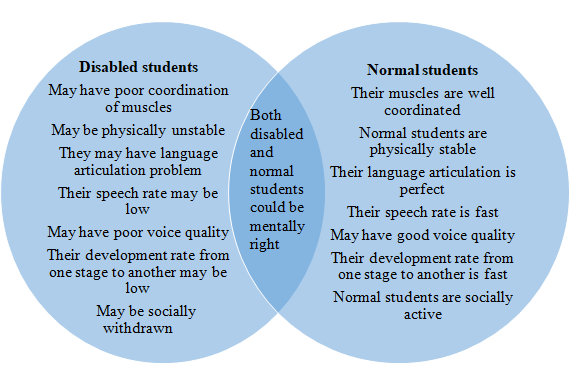Introduction
Normal children and children with disabilities have similarities and differences during their development processes. The rates and steps of development involved may vary from one child to another. In the first nine years, there are stages that all children go through. The milestones should be the reasonable ranges that the children would have (Oesterreich, 2005).
Similarities and differences between disabled and normal children in child development
The Venn diagram below shows the similarities and differences in the development of normal and disabled students.

In physical development, the child with a disability may have problems with motor activity. This is due to poor coordination of muscles, abnormality in the movement of some muscles, or paralysis. For example, they may not be able to run down the stairs, jump several times without losing control, and hold certain objects for long with stability.
This, however, does not mean that the children will have lower mental power than those without disabilities. They may just be able to do mental exercises as much as those who are physically fit (LD Online, 2000).
There can also be problems caused by abnormal functioning of the tongue muscles or abnormality in the respiratory tract. This makes it difficult for the child to talk. Some people may think the individual is mentally retarded but this could not be the case. Complaints of physical conditions or tiredness are also a common occurrence among such children even when there is no medical problem.
Students with problems in social development are poor in initiating and maintaining relationships with their age mates or adults. They may have frequent mood swings. The children may also have problems in the mental development but will be physically normal like the other children with no social disorders who have no problems in movement or performing usual personal tasks (LD Online, 2000).
This may lead to problems in social development due to the embarrassment the child may be regularly going through because of mistakes they make in speech. This may make them grow up seriously withdrawn and not socialize well with others.
In language development, there are students who may be having problems in interpretation, articulation, or replication of language. The articulation problem, for example, may mean that the child has problems with learning with phonetics. This means that the child may not be able to blend several sounds to come out with words which are understandable by others.
The student will have a slow rate of making a speech and not be fluent in his or her rhythm. The voice quality and volume may be low and the child may not be able to use certain parts of speech well. The mental development can be similar to that of other children with no disabilities unless they get too much negativity from society, which can affect them (Oesterreich, 2005).
The children with cognitive disabilities may have problems of sitting up, crawling, and walking compared to their peers who are normal.
They may also have impaired speech or take a long duration before learning to speak. The children may be poor in logical thinking and problem solving, but they may still physically handle things with ease as their peers with no mental retardation. Their only problem will be taking longer to develop certain aspects of their physical nature.
References
LD Online. (2000). Early Identification: Normal and Atypical Development.
Oesterreich, L. (2005). Ages and stages: Individual differences. Iowa, USA: Iowa State University Extension.